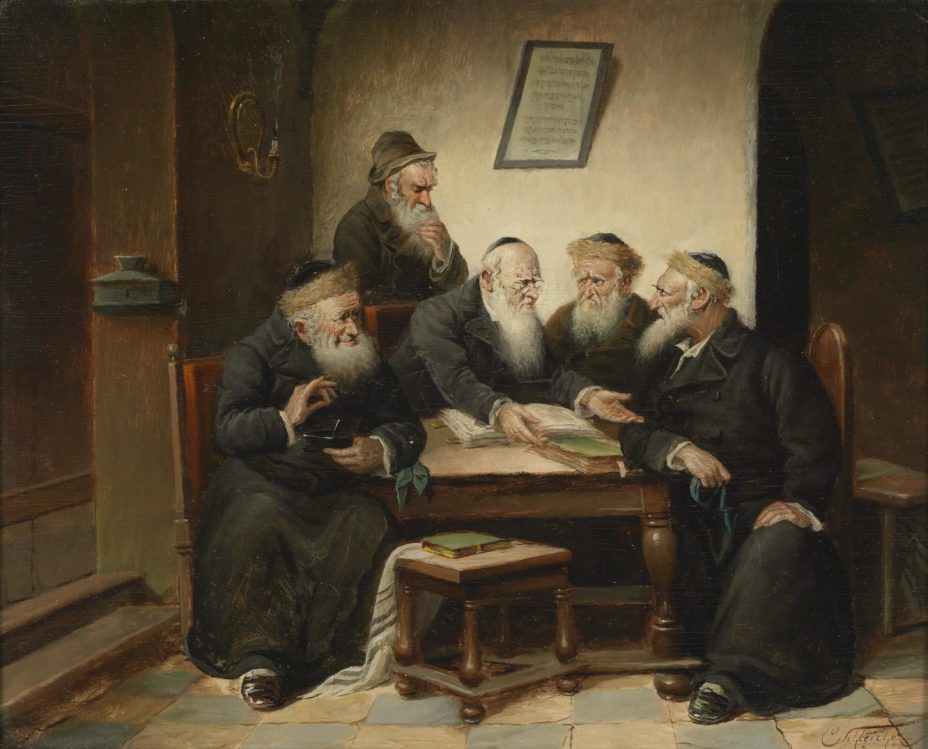We have seen before that it was the norm of pre-Islamic society to contract marriages between men and prepubescent girls, and yet the consummation of such marriages was shunned until after girls reached sexual and social maturity and were able to take on the full role as adult women and manage their own households.
Muhammad, however, changed that. He had contracted marriage with Abu Bakr’s daughter Aisha in Mecca when Aisha was six years old. Instead of waiting until she was mature, he decided to consummate the marriage in Medina soon after the Hijra.
What changed? Why did Muhammad decide to overturn the cultural norms and taboos of his society by having sex with a little girl?
Most often, this action is attributed solely to Muhammad’s perversion. He wanted to have sex with a little girl. He was the prophet, and so he got what he wanted.
This, of course, has a good deal of validity. He would not have had sex with the tiny Aisha if he did not want to have sex with a child, of course. But why did he feel that this was suddenly an option for him when he had already waited three years?
One reason he might have delayed is that right after Aisha’s marriage contract was signed, she got extremely sick, and all her hair fell out. When Muhammad consummated their marriage three years later, her hair had only reached her ears again.
But I believe that there is another reason, which is intimately linked to his arrival in Yathrib/Medina and his first real exposure to Talmudic Judaism.
After the crucifixion of Jesus and the destruction of the Temple, Judaism was in theological disarray. Many of the doctrines and discussions that scholars had held before pointed to Jesus as the Messiah, and to maintain the integrity of Mosaic Judaism, these things needed to be purged. As I’ve discussed before, this resulted in the doctrine of Torah Mi Sinai, or the Torah from Sinai. This is the belief that the entirety of the Torah was handed down to Moses on Mount Sinai, including every line of law and every action before and after that moment. This was an attempt to replace Jesus as the Word of the Lord with something else, as well as to give a kind of eternal legitimacy for the Torah. The rabbis also adopted the impossible belief that all the patriarchs before Moses knew about and followed the Torah, too, even though their own actions in the Bible explicitly show otherwise.
Because of this false doctrine, the rabbis believed that all laws that ever needed to exist, that ever showed right from wrong, were exactly encoded in the written Torah and the tradition of the “oral Torah,” and all that remained to be entirely right with God was to correctly interpret these traditions. This alone resulted in a grotesque misinterpretation of the Mosaic Law, but it got worse. These pharisaical rabbis were so far removed, both temporally and culturally, from the Bronze Age that they did not even remember how law codes worked for their ancestors, and so they applied the brutal principles of Roman Law to this new understanding of Mosaic Law. It was in the Talmud where these interpretations were recorded, among other things.
Moreover, the rabbis responsible for the compilation of the Talmud and for a decent amount of contributions to it were in Babylon, which is why it is called the Babylonian Talmud. If you know anything about biblical history, you know that Babylon was considered to be a place of moral dissipation, where disgusting behaviors and excesses were normalized. In the context of this culture, then, the Babylonian Talmud was compiled. And in Sassanian Babylon, unlike in ancient Israel, we do have evidence of child-marriage.
One of Jesus’ major condemnations of the Pharisees (that is, the school from which the rabbis would come) was their treatment of the law of Moses, not to guide people to true goodness but rather to be finely sliced and interpreted so that they could, with corrupt hearts, still behave in accordance with their interpretation of the law so that they felt justified before God in their hypocrisy. To the Pharisees, the law was used as a vehicle for justification–that is, they felt clean before God because they followed the law. Jesus taught, instead, that the purpose of the law was to teach humility–that is, because all err against the spirit of perfect justice, all should feel their need for the sin-offerings that are given to cover their transgressions. This is paralleled by the longest section of the Old Testament quoted verbatim in the New Testament, in the Epistle to the Hebrews, which comes from Jeremiah 31. Including a little bit before it, this is what it says:
27 “The days are coming,” declares the Lord, “when I will plant the kingdoms of Israel and Judah with the offspring of people and of animals. 28 Just as I watched over them to uproot and tear down, and to overthrow, destroy and bring disaster, so I will watch over them to build and to plant,” declares the Lord. 29 “In those days people will no longer say,
‘The parents have eaten sour grapes,
and the children’s teeth are set on edge.’30 Instead, everyone will die for their own sin; whoever eats sour grapes—their own teeth will be set on edge.
31 “The days are coming,” declares the Lord,
Jeremiah 31, NIV
“when I will make a new covenant
with the people of Israel
and with the people of Judah.
32 It will not be like the covenant
I made with their ancestors
when I took them by the hand
to lead them out of Egypt,
because they broke my covenant,
though I was a husband to them,”
declares the Lord.
33 “This is the covenant I will make with the people of Israel
after that time,” declares the Lord.
“I will put my law in their minds
and write it on their hearts.
I will be their God,
and they will be my people.
34 No longer will they teach their neighbor,
or say to one another, ‘Know the Lord,’
because they will all know me,
from the least of them to the greatest,”
declares the Lord.
“For I will forgive their wickedness
and will remember their sins no more.”
Note that in Jeremiah, God is explicitly rejecting an ancient principle of justice which had been encoded into some parts of the Torah–that is, certain types of corporate guilt. Because God related to the people in Moses’ times in terms of guilt that they were capable of understanding, corporate guilt for some crimes was accepted into Mosaic law. Here, however, God is rejecting this human understanding of justice with which he cooperated for a time in exchange for a higher, truly divine sense of justice.
This is also reinforced by Paul, who writes,
3 And you show that you are a letter from Christ delivered by us, written not with ink but with the Spirit of the living God, not on tablets of stone but on tablets of human hearts.
4 Such is the confidence that we have through Christ toward God. 5 Not that we are sufficient in ourselves to claim anything as coming from us, but our sufficiency is from God, 6 who has made us sufficient to be ministers of a new covenant, not of the letter but of the Spirit. For the letter kills, but the Spirit gives life.
7 Now if the ministry of death, carved in letters on stone, came with such glory that the Israelites could not gaze at Moses’ face because of its glory, which was being brought to an end, 8 will not the ministry of the Spirit have even more glory?
Corintians 3:3-8, ESV
The Talmud was a very strong rejection of these principles, essentially a double-or-nothing take on Mosaic Law, and the results of such a very precise and narrow view are predictable. In the high Middle Ages, after extended contact with Christian culture, some of the most awful abuses encoded and normalized in the Talmud were revoked through the clever reinterpretation of the greatest rabbis. (The influence of Islamic culture on the same rabbis was less benign, however.) Maimonides (Moses ben Maimon, or Rambam), born into the multi-religious environment of Cordova, Spain, ended child marriage among the Jews whom he influenced, even though they were not living under Roman law.
However, this is not the period of those great rabbis. This was, instead, a period shortly after the formulation of the Talmud, during which Jews lived according to the Talmud because that is all they had.
Mosaic law does not give a minimum age of consent. The reason for this is very simple–consummating marriage with a child did not even enter the minds of ancient Israelites, for whom marriage was synonymous with taking up the position of an adult. Men were required in ancient Israel to start a separate household upon marriage, which the wife had to be old enough to run competently. Just like in pre-Islamic pagan Arabia, that meant that a woman had to make the daily bread, milk the animals, cook food, and spin and weave. These were the major activities of a Hebrew wife, and it’s not something a child is capable of doing. Hebrew culture did not even have awareness of the existence of pedophilia–a woman’s breasts were a fundamental part of her sexual attractiveness, as is highly evident in the Song of Solomon. Contrary to the teachings of Torah Mi Sinai, most of the laws in the Torah are actually a compendium of case law, and because no one ever came up to Moses and said, “Is it okay if I have sex with this six-year-old?” Moses never said, “If a man lies with a child, he will be stoned.”
To anyone who takes the Torah as exactly what it represents itself to be, this is obvious. The moral reasoning needed to understand what justice would demand in the case of this kind of violation is also what is expected of a Christian. Therefore, child sex was generally a capital offense in Christian countries until the 1800s.
The lack of this specific prohibition takes on a very different meaning under the doctrine of Torah Mi Sinai, in which the full and perfect law for all times was dropped in the lap of Moses. If God didn’t forbid a thing in the Torah, according to this view, it can’t really be wrong. And that includes sex with children.
Therefore, the Talmud sets the minimum age for girls to be married and have intercourse at three years and one day, because until a child is more than three years old, a child is considered to be at least potentially a nursing infant, and it is a Talmudic principle that infants are to be with their mothers. A child also had to be old enough to utter the words, “I like him,” something a three-year-old can do, since the pretext of consent was maintained. Therefore, once a little girl is beyond the age of weaning, she can be married off, and her husband can have as much sex with her as he pleases. This, too, is made explicit in the Talmud: “A girl of three years and one day may be betrothed by intercourse; if the yambam had intercourse with her, he acquires her thereby; the guilt of adultery may be acquired through her….” (Tractate Niddah, Folio 44b). The “yambam” means the brother of a man who died–so if a man marries a girl aged three years and one day and dies immediately having sex with her, then his brother can claim her as his wife by having sex with here that same day.
Girls between the ages of eleven years and one day and twelve years and one day may use a contraceptive sponge, because giving birth at that age is sometimes possible but is considered to be too dangerous. Girls younger and older than that age, however, must go about her intercourse duties as normal because they won’t get pregnant (Tractate Niddah, Folia 45a). Whenever a prepubescent girl is injured by sexual intercourse so that she starts to bleed from the trauma, her husband must refrain from having sex with her for a set amount of time so that he is not made unclean. With an adult woman or even young teen, that would be until her next menstruation, but of course a small child doesn’t menstruate, so a special waiting period is set for prepubescent girls (Kethuboth 5a).
Because these rabbis thought their laws were endorsed by God, they also believed that God made special provision for girls who are sexually assaulted before that age–they believed that the hymen literally regrew and so “[w]hen a grown-up man has intercourse with a little girl it is nothing, for when the girl is less than this, it is as if one puts the finger into the eye,” and so there was no moral guilt or legal punishment or any kind of recourse for the assaulted infant (Tractate Niddah, Folio 44a). Boys are considered sexually “adult” at nine years, and so there is no punishment or moral guilt for sexually assaulting a boy under that age. Pederasty, therefore, does not accrue guilt in the Talmud as long as the boy is under nine years and one day.
It is also crystal clear in the Talmud that these were not theoretical situations, as some claim, but that little girls were, in fact, married off at this age. Specific examples and conversations regarding specific real-life situations were used to illustrate some of these rules.
But the cultural requirements of wives being the manager of an independent household should have still prevented little girls from being treated in this way if it were not for a major shift in Jewish culture. The Talmud takes an almost fetishistic view of reproduction, taking the blessing of Abraham and turning it into a command–every man is under the legal obligation to reproduce, and the sooner, the better.
In the first century, it wasn’t uncommon for Jews to never marry at all, and marriage was not particularly early for them, at any rate. The world they were in was not particularly abundant with resources, and so it took most men a while to be able to set up his own household in order to afford a wife and family, in accordance with ancient Jewish custom and, yes, pre-Talmudic law.
After the destruction of the Temple, rabbis decided that this was an error–perhaps they thought that if Jesus and his disciples had been tied down with wives, Christianity would have never happened. So they taught a doctrine of reproduction that prioritized marriage such that fourteen was considered the ideal age for a boy to get married, and marriages after the age of twenty were an affront to God. (If you want to know how seriously this is taken, even today, some Hasidic communities maintain that delaying marriage until 18 is harmful and an “invitation to sin.”)
The entire structure of the Jewish family had to change to accommodate these rulings. No longer was a marriage synonymous with setting up a household, because how many fourteen-year-olds could be self-supporting? The parents of the boy would provide the newly married couple a niche in the family home, and so it was no longer culturally necessary for the husband or wife to be able to take on adult roles. This, then, facilitated the widespread acceptance of child marriage. The Talmud also teaches that forty days before a male child is conceived, a voice from heaven declares who he is going to marry. This, then, gives a deterministic validation to any legal marriage: that three-year-old little girl was married to a sixteen-year-old boy because God decreed it would happen, so you can’t say anything against it!
The Anti-Defamation League does not like it when people reveal what the Talmud says. They claim that people take things out of context when actually, the context makes the teachings of the Talmud far more morally reprehensible. They claim that such people are ignoring “Judaism’s long history of social progress.” I am not doing that. In the high Middle Ages, a number of rabbis used their authority of interpretation to remove some of the most grotesque and revolting rulings of the Talmud. However, many of the awful things in the Talmud are still actively taught, especially in Ultra-Orthodox circles, where cheating, stealing from, and lying to gentiles (and on taxes!) is not only permitted but actively promoted, as long as it is done in the right way.
But it’s a third claim that makes me very, very angry. The ADL claims that the Talmud is being wrongly judged out of its time, as if two thousand years ago (or really, about 1800 years ago), this would not have been a depraved and disgusting code of law that any person with a functioning moral reason would find reprehensible.
On that, the ADL is wrong. Talmudic Judaism of the 2nd and 3rd centuries was a leap into a moral abyss from what Jewish morality had been before that point. It was a perversion. It did not represent, even in the context of its era, any kind of moral standard that a decent human being would want to follow. The rabbis actually outlawed many of the common practices that had developed to elevate the status of women by that point, banning provisions in marriage contracts that had become standard that gave women equal rights to divorce and support if they were mistreated. And they defied the cultural norms of standard decency that had prevailed for years among not only Jews but their neighbors.
Christianity became more and more forceful about rejecting Judaizing precisely under this influence. The Law of Moses truly was the law of death because this is how people chose to abuse it–to justify any number of perversions and to remove guilt from any number of heinous crimes.
The very fact that the ADL can imagine that Moses himself would not have thrown the Talmud into the fire is obscene. The very heart of Talmudic Judaism is corrupt. To be an observant Talmudic Jew, you must either be ignorant (just as many Muslims are), you must lie to yourself and pretend that this filth would have been “more moral” than that of other cultures in its time (except that it still forbade infanticide, it most certainly was not), or you must reason that God really did guide his people to make rulings such as these but it’s okay because it’s been made better by the last 1600 years or so of rabbinic interpretations. The alternative is non-Talmudic Judaism–in rejecting the Talmud, however, these Jews inevitably reject any impersonal moral standard and so feel free to make up morality to suit their tastes as they go along, which leads straight into endorsing their own set of abuses. There is a segment of the Modern Orthodox Judaism that manages to steer a middle course, upholding the Torah and roundly condemning pretty much the entire Talmud at the same time, which is admirable, but this represents a modern (and minority) departure from the last 1600 to 1800 years of Judaism, a strand of Judaism that simply did not exist even a thousand years after Muhammad’s life.
This gives the perfect backdrop for the deep ambivalence of so many Jews about their religion today, the radically different streams of Judaism, and the strong prejudice against non-Jews and the routine abuse of non-Jews that prevails among the observant Jewish communities–in the Talmud, it is explicitly forbidden to take any act whatsoever to save the life of a non-Jew. Jewish doctors are forbidden by the Talmud from performing any procedure that might save the life of a gentile, and if a Jew were to see a gentile child drowning in a river, he is religiously obligated by the Talmud from taking any action that might save the child, whether it is personal action or by raising the cry to even alert someone else to the child’s situation.
This is only the beginning of the kinds of things that the Talmud teaches, many of which violated ancient cultural norms of Semitic decency, much less the higher standards that are actually encoded in the Torah! After reading the Talmud myself, I understood for the first time why anti-Jewish riots were common in medieval Europe whenever gentiles got hold of a Talmud that they were able to read, and I even understood why “blood libel” (the false claim that Jews ritually killed or sacrificed gentile children for various reasons) seemed so plausible to so many people for so long. The Talmud was not a shining example of morality for its age but a dreadful step into moral debasement.
Ignorance of Jewish religious practice increased tolerance to Judaism. Once people knew what Talmudic Judaism taught, though, they generally wanted the Jews out of their city, and they believed that anyone who believed such vile things had to be capable of untold horrors. Many of the expulsions of the Jews have been triggered not by ignorance or prejudice but by someone who wasn’t supposed to be allowed to have the Talmud getting ahold of it and finding out what it said, and the moral horror that resulted. The question of what should be done about a group of people who lives among us and yet desires our destruction as a matter of principle is truly an ancient one for the West! Although there were (and are) Talmudic Jews who were quite sincerely decent and moral people, this was not because of the Talmud but rather in spite of it. Once again, they are (and were) better people than their religion taught them to be.
This is not to say that all the claims made against Jews or Jewish beliefs were true, nor is it to say that any individual should be condemned because of the actions of another. Again, it is a basic Christian principle that in the Church Age, people “will no longer say, ‘The parents have eaten sour grapes, and the children’s teeth are set on edge.’ Instead, everyone will die for their own sin; whoever eats sour grapes—their own teeth will be set on edge.” Retaliating against a group of people for the actions of some of them is therefore against a general Christian principle–never mind the obscene miscarriage of justice that blamed Jews for World War I instead of putting the blame on the Great Game of the great powers and Otto von Bismark’s morally bankrupt materialist policy of realpolitik, which rejected Christian standards of behavior and culminated in an absurd war that resulted in approximately 22 million military and civilian deaths.
At any rate, when Muhammad came to Yathrib in AD 622, he encountered Talmudic Judaism for the first time, as it was practiced in its fully raw form in the seventh century, before the reforms of the high Middle Ages and later. And when the Jews found out that he was married to Aisha but wasn’t having sex with her yet, the Jews, knowing the Talmud, would have asked why, if Muhammad was a follower of the God of Israel, did Muhammad not know that he did not have to wait for the little girl to grow up but could have sex with her right then? (It should be noted the Muhammad’s marriage to Aisha did actually violate the Talmud in one way, however–a father who marries his young daughter to an old man is considered to be worse than if he prostituted her, according to the Talmud.)
So Muhammad realized that he could fulfill his lusts immediately, and a consultation with Jibril would never tell him that he couldn’t do anything he wanted to do, so he ordered Aisha to his house to have intercourse with her, and he set her up in her own little house, after the pagan Arab fashion, even though she was hopelessly incapable of taking care of it.
Muhammad’s encounters with the Talmud have proven tragic for generations of little girls and for Muslims in general, as much of sharia law and the Islamic Deen, as well as its principles, owe a great deal to Muhammad’s reactions to and interpretations of the Talmud. The Talmud is a collection of books that, at its best, finely slices moral law with amoral exactitude, and at its worst, promotes abominations. This was passed on to Islam through the filter of Arab warrior culture and oral tradition, and the results have been as bloody, oppressive, and terrible as one would expect.






